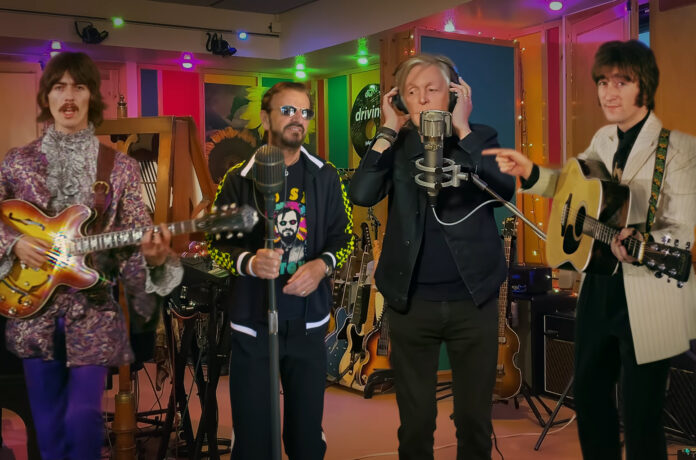The Beatles’ iconic Shea Stadium gig took place on August 15, 1965.
Among the 56,000 screaming fans in attendance, mostly young girls and women, was a nine-year-old Whoopi Goldberg. She witnessed the Fab Four’s milestone 30-minute show, which featured a 12-song set. This concert was the first to be performed in a major American sports stadium, setting a trend that works even today.
However, the technology at the time was lacking, and the band’s sound was amplified to the crowd using equipment similar to school cafeteria and hallway monitors in ’80s teen dramas. Consequently, the band members couldn’t hear each other playing due to the overwhelming screams from the frenzied New York crowd.
This disappointing sound experience catalyzed John, Paul, George, and Ringo to stop touring the following year and focus on becoming the best studio band for their enduring career. Retreating to a place where they had control over the technology ultimately served everyone, especially the band, that much better.
In 1971, John Lennon reflected on the Shea Stadium concert, stating, “I saw the top of the mountain on that unforgettable night.”
Doesn’t it seem that with every technological mountain we climb as a society (some of us more willingly than others), we drag The Beatles right alongside, like an emotional support animal, to keep us company in the new digs? Just as we update our luggage or operating systems, the culture updates the Fab Four. Consider the evolution from LPs to cassettes to CDs to iPods—The Beatles were adapted, especially the catalog, to these changes.
In 2021, during the production of Get Back, a documentary compiled from 1969 footage of the band creating the album-concert-film that would eventually be known as Let It Be, film director Peter Jackson and his team utilized Artificial Intelligence technology to isolate individual instruments and voices in the recordings.
So, as announced in Pitchfork earlier this month, The Beatles have finally unveiled their “last song,” or so we think, “Now and Then.” The track features a John Lennon vocal that was discovered on tape by in 1994, and given by Yoko Ono to the rest of the band for completion. Paul McCartney, George Harrison, and Ringo Starr collaborated on finishing song during the creation of “Real Love” and “Free as a Bird” in 1995. The track was initially shelved due to poor audio quality, but was revived this year with the help of AI, to enhance Lennon’s performance.
Help us save local journalism!
Every tax-deductible donation helps us grow to cover the issues that mean the most to our community. Become a 48 Hills Hero and support the only daily progressive news source in the Bay Area.
“Now and Then,” according to Billboard, blew up Spotify’s rankings as the most-streamed song worldwide. Despite half the band being deceased, the group surpassed even the biggest star in the world on this platform. On Thursday, November 2, “Now and Then” became the No. 1 most-streamed song in the UK on Spotify, with just under 387,000 streams in less than a full day, displacing Taylor Swift’s new track “Is It Over Now?” (another track resurrected from the past, but that’s a whole different story). Sorry, Swifties.
It’s an impressive work, a melancholic song that evokes feelings of loss and the passing of unbridled youth, with John Lennon giving his final tribute to his comrades.
However, the video, also directed by Jackson, is extremely creepy.
It’s an onslaught of old Beatles live-action shots, juxtaposed with more recent footage of the Fab Four in various stages of their career—from their early gigs in Berlin wearing leather outfits to their appearance on Ed Sullivan in mop-top suits, to their Sgt. Pepper’s costumes, and finally the long-haired, mutton chopped, mustached phase during the Let It Be era.
But it raises the question, just because we have the technology, do we need to use it? It’s strange and sad to see modern images of Paul looking back at a younger version of George Harrison and John Lennon with a melancholic expression in his eyes, while John jitters and smiles in what could be a tepid apology across the void to his musical brother. I’m sure it’s meant to be heartfelt, but the whole thing could easily pass as a subtly chilling montage from John Carpenter’s Halloween.
And let’s not assume that only Baby Boomers are buying into this “last trip” scenario. Oh no, Blackbird. Gen-Z and Millennials alike stay fascinated with these icons that existed before the Twitter-finger era, who can still shape popular culture without the influence of X or whatever Elon Musk is currently disrupting.
So, with all this newfound buzz surrounding the English rock band formed in Liverpool in 1960 that just won’t ever go away, what could be waiting around the corner? Can we expect the release of previous collections, now mixed in Stereo and Dolby Atmos, for the 2023 holiday season?
Yes indeedy. The Beatles/1962-1966 (often referred to as The Red Album) and The Beatles/1967-1970 (The Blue Album) will be released in special edition packages this month. Originally dropped in 1973, three years after The Beatles’ breakup, these albums reached No. 3 and No. 1 respectively on the Billboard charts.
Let’s see what being in control of 2023 technology can bring to The Beatles this time.






